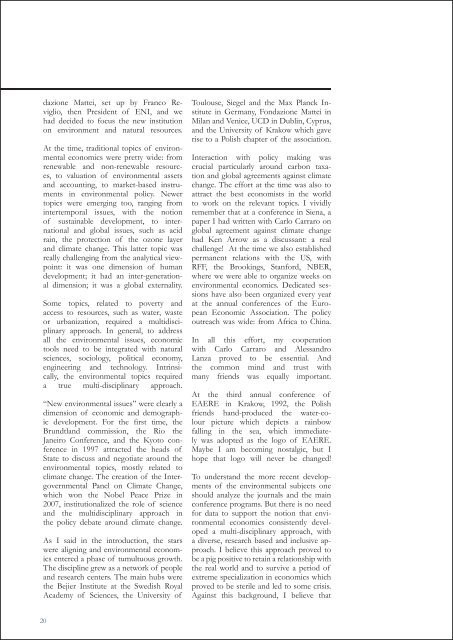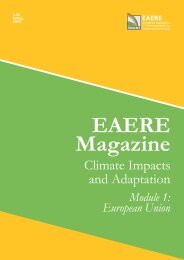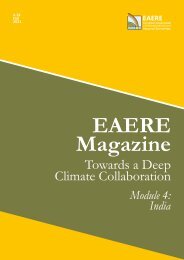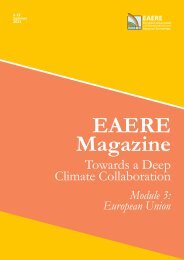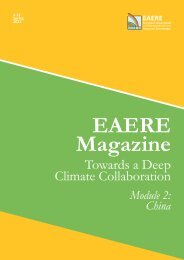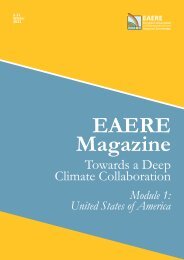You also want an ePaper? Increase the reach of your titles
YUMPU automatically turns print PDFs into web optimized ePapers that Google loves.
dazione Mattei, set up by Franco Reviglio,<br />
then President of ENI, and we<br />
had decided to focus the new institution<br />
on environment and natural resources.<br />
At the time, traditional topics of environmental<br />
economics were pretty wide: from<br />
renewable and non-renewable resources,<br />
to valuation of environmental assets<br />
and accounting, to market-based instruments<br />
in environmental policy. Newer<br />
topics were emerging too, ranging from<br />
intertemporal issues, with the notion<br />
of sustainable development, to international<br />
and global issues, such as acid<br />
rain, the protection of the ozone layer<br />
and climate change. This latter topic was<br />
really challenging from the analytical viewpoint:<br />
it was one dimension of human<br />
development; it had an inter-generational<br />
dimension; it was a global externality.<br />
Some topics, related to poverty and<br />
access to resources, such as water, waste<br />
or urbanization, required a multidisciplinary<br />
approach. In general, to address<br />
all the environmental issues, economic<br />
tools need to be integrated with natural<br />
sciences, sociology, political economy,<br />
engineering and technology. Intrinsically,<br />
the environmental topics required<br />
a true multi-disciplinary approach.<br />
“New environmental issues” were clearly a<br />
dimension of economic and demographic<br />
development. For the first time, the<br />
Brundtland commission, the Rio the<br />
Janeiro Conference, and the Kyoto conference<br />
in 1997 attracted the heads of<br />
State to discuss and negotiate around the<br />
environmental topics, mostly related to<br />
climate change. The creation of the Intergovernmental<br />
Panel on Climate Change,<br />
which won the Nobel Peace Prize in<br />
2007, institutionalized the role of science<br />
and the multidisciplinary approach in<br />
the policy debate around climate change.<br />
As I said in the introduction, the stars<br />
were aligning and environmental economics<br />
entered a phase of tumultuous growth.<br />
The discipline grew as a network of people<br />
and research centers. The main hubs were<br />
the Bejier Institute at the Swedish Royal<br />
Academy of Sciences, the University of<br />
Toulouse, Siegel and the Max Planck Institute<br />
in Germany, Fondazione Mattei in<br />
Milan and Venice, UCD in Dublin, Cyprus,<br />
and the University of Krakow which gave<br />
rise to a Polish chapter of the association.<br />
Interaction with policy making was<br />
crucial particularly around carbon taxation<br />
and global agreements against climate<br />
change. The effort at the time was also to<br />
attract the best economists in the world<br />
to work on the relevant topics. I vividly<br />
remember that at a conference in Siena, a<br />
paper I had written with Carlo Carraro on<br />
global agreement against climate change<br />
had Ken Arrow as a discussant: a real<br />
challenge! At the time we also established<br />
permanent relations with the US, with<br />
RFF, the Brookings, Stanford, NBER,<br />
where we were able to organize weeks on<br />
environmental economics. Dedicated sessions<br />
have also been organized every year<br />
at the annual conferences of the European<br />
Economic Association. The policy<br />
outreach was wide: from Africa to China.<br />
In all this effort, my cooperation<br />
with Carlo Carraro and Alessandro<br />
Lanza proved to be essential. And<br />
the common mind and trust with<br />
many friends was equally important.<br />
At the third annual conference of<br />
<strong>EAERE</strong> in Krakow, 1992, the Polish<br />
friends hand-produced the water-colour<br />
picture which depicts a rainbow<br />
falling in the sea, which immediately<br />
was adopted as the logo of <strong>EAERE</strong>.<br />
Maybe I am becoming nostalgic, but I<br />
hope that logo will never be changed!<br />
To understand the more recent developments<br />
of the environmental subjects one<br />
should analyze the journals and the main<br />
conference programs. But there is no need<br />
for data to support the notion that environmental<br />
economics consistently developed<br />
a multi-disciplinary approach, with<br />
a diverse, research based and inclusive approach.<br />
I believe this approach proved to<br />
be a pig positive to retain a relationship with<br />
the real world and to survive a period of<br />
extreme specialization in economics which<br />
proved to be sterile and led to some crisis.<br />
Against this background, I believe that<br />
20


